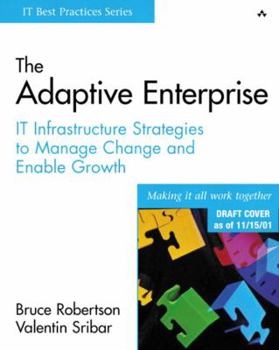The Adaptive Enterprise: It Infrastructure Strategies to Manage Change and Enable Growth
Select Format
Select Condition 
Book Overview
A five-step infrastructure planning process that simplifies application development, deployment, and integration. The text includes in-depth coverage of platforms, patterns, and services and it should... This description may be from another edition of this product.
Format:Hardcover
Language:English
ISBN:0201767368
ISBN13:9780201767360
Release Date:January 2002
Publisher:Addison-Wesley Professional
Length:320 Pages
Weight:1.60 lbs.
Dimensions:0.8" x 7.6" x 9.6"
Customer Reviews
2 ratings
Learn to keep pace by being adaptive rather than driven
Published by Thriftbooks.com User , 20 years ago
Although to many, the rate of change in the IT area has slowed down from the frenetic pace of the dot com era, to most that is just as much an illusion as the false profits of the dot com era were. The rate of change is still rapid, and in many areas the extent of the change is hidden. If your task is to make a "small" change to a large program, that single change may be monumental, in approach, execution and consequences. Therefore, when talk turns to being an adaptive enterprise, it must include both the ability to create new products in order to enter new markets and the capability of adapting current products to respond to smaller changes in customer needs. It is not possible to consider one to be microchanges and the other macrochanges, as either one could be large or small depending on the circumstances. In both cases, it is not possible to be adaptable without adopting the appropriate mindset, which involves emotional and organizational adjustments. Emotionally, one must become tolerant of change and organizationally, it is necessary for information to flow quickly and in both directions along the hierarchy chart. The emphasis in this book is on the organizational adjustments that need to be made, although the emotional adjustments are occasionally mentioned. The organizational adjustments are handled very well, described in enough detail so that there is no ambiguity in understanding what they are and how they are performed. The emphasis is on reusable components, not all of which are constructed of software. In chapter 2, there are descriptions of the physical components, functional components and interface components. Several different types of organizational patterns are described, what they are, how they are used as well as the consequences of their use. Chapter 3 covers the general categories of transact patterns, publish patterns and collaboration patterns. A transact pattern is any application that writes structured information to a system. Publish patterns deal with data that is presented in a read-only form, although it also includes any summaries and other analysis done on the data. The collaborate patterns deal with the sharing of data between peers. Each pattern covered is then summarized in sections describing the benefits of using it as well as the weaknesses that it exhibits. In chapter 4, the emphasis is on the creation of adaptive services, which are shared structures that are static and permanent, reusable and have a different lifecycle than the physical infrastructure. As the authors mention, the key to providing adaptive services is to identify those parts that need to change independently, and structure the service so they can be altered without changing the other components. Chapters 5, 6 and 7 deal with the strategies used to define the business problem(s) to be solved, developing arguments to justify the project and obtain the funding, managing per-project processes as well as periodic processes, communicating w
Brings Infrastructure Management to a New Level
Published by Thriftbooks.com User , 22 years ago
The infrastructure management approach that the authors give in this book incorporates practices from systems (and software) engineering, and is a blueprint for success. The objectives are: (1) end-to-end management with no gaps in ownership, (2)cost efficiencies through reuse and component-based strategies, (3)holistic view that looks at business, operational and technology (instead of the common 'technology only' view), and adaptability (an infrastructure that is managed to long range goals, but can be quickly adapted to emerging and immediate business needs).How the authors meet these objectives is by identifying physical, functional and interface components that make up the infrastructure and integrating them into a service-oriented framework. This is consistent with component-based software engineering, and it is a remarkably good fit to infrastructure management. Moreover, the authors introduce patterns, also borrowed from software and systems engineering disciplines, to map business requirements to design in an efficient manner that promotes reuse. Another advantage of patterns is this approach captures knowledge (something not directly pointed out in the book). If you're not familiar with process patterns the book I recommend for infrastructure professionals is More Process Patterns by Scott Ambler. This is the second of a two book set and it directly addresses patterns that are related to infrastructure (the first book, Process Patterns, is more focused on software engineering).The two chapters I liked the most are 4, Developing Adaptive Services, and 5, Services Starter Kit. These chapters tie services to infrastructure and go into fine detail about how to integrate services and the underlying technology. I especially like the way the authors use multiple life cycle management for each layer in the infrastructure. Chapters 6 (Processes and Methods) and 7 (Packaging and People) neatly pull together the preceding chapters into a coherent, process-oriented strategy. The single appendix is also valuable because it gives a comprehensive component catalog. This catalog can be used as the basis of the infrastructure blueprint as well as the foundation of an encompassing asset management initiative.




